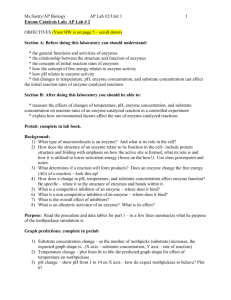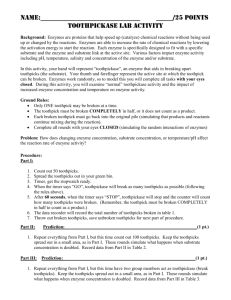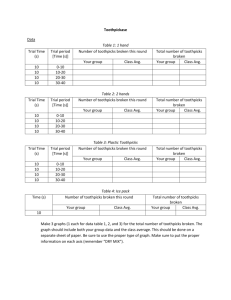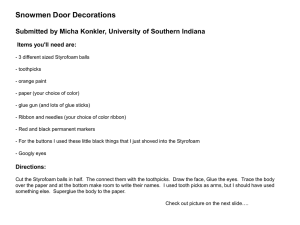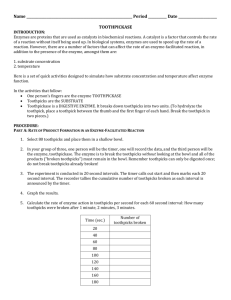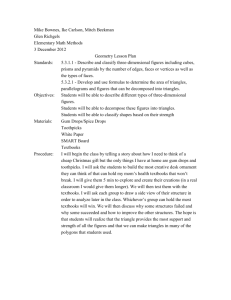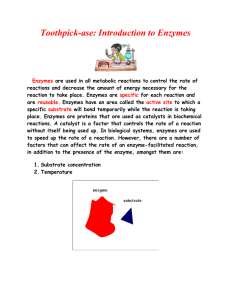Ms. Bortz 3rd Period Toothpickase Lab Problem: How does
advertisement
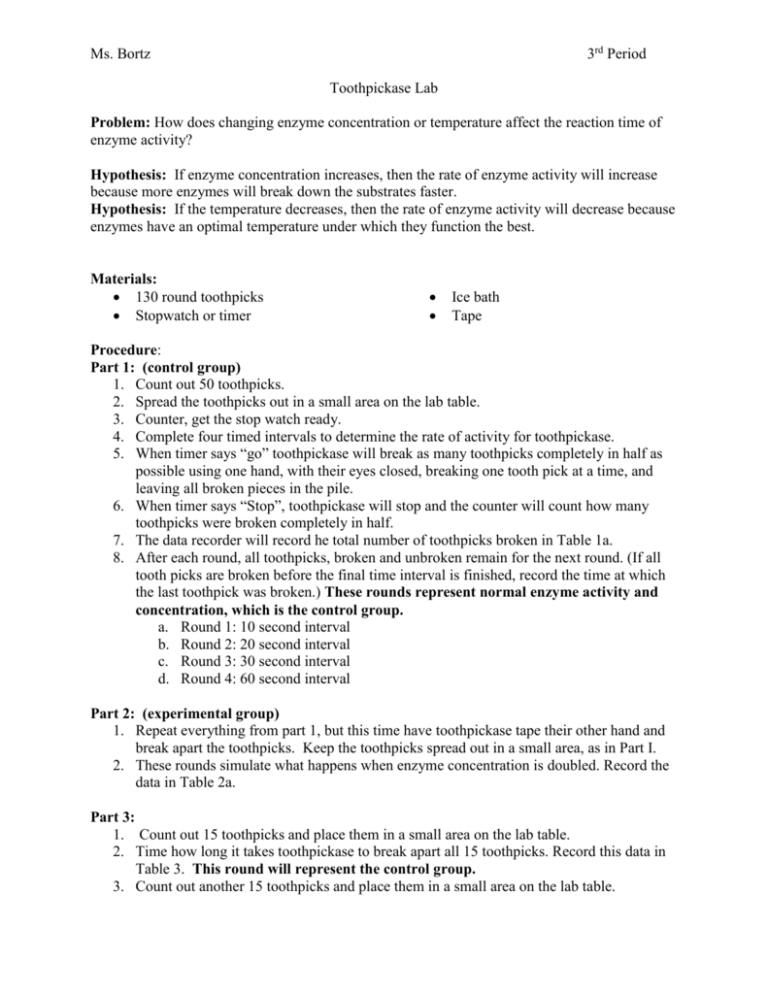
3rd Period Ms. Bortz Toothpickase Lab Problem: How does changing enzyme concentration or temperature affect the reaction time of enzyme activity? Hypothesis: If enzyme concentration increases, then the rate of enzyme activity will increase because more enzymes will break down the substrates faster. Hypothesis: If the temperature decreases, then the rate of enzyme activity will decrease because enzymes have an optimal temperature under which they function the best. Materials: 130 round toothpicks Stopwatch or timer Ice bath Tape Procedure: Part 1: (control group) 1. Count out 50 toothpicks. 2. Spread the toothpicks out in a small area on the lab table. 3. Counter, get the stop watch ready. 4. Complete four timed intervals to determine the rate of activity for toothpickase. 5. When timer says “go” toothpickase will break as many toothpicks completely in half as possible using one hand, with their eyes closed, breaking one tooth pick at a time, and leaving all broken pieces in the pile. 6. When timer says “Stop”, toothpickase will stop and the counter will count how many toothpicks were broken completely in half. 7. The data recorder will record he total number of toothpicks broken in Table 1a. 8. After each round, all toothpicks, broken and unbroken remain for the next round. (If all tooth picks are broken before the final time interval is finished, record the time at which the last toothpick was broken.) These rounds represent normal enzyme activity and concentration, which is the control group. a. Round 1: 10 second interval b. Round 2: 20 second interval c. Round 3: 30 second interval d. Round 4: 60 second interval Part 2: (experimental group) 1. Repeat everything from part 1, but this time have toothpickase tape their other hand and break apart the toothpicks. Keep the toothpicks spread out in a small area, as in Part I. 2. These rounds simulate what happens when enzyme concentration is doubled. Record the data in Table 2a. Part 3: 1. Count out 15 toothpicks and place them in a small area on the lab table. 2. Time how long it takes toothpickase to break apart all 15 toothpicks. Record this data in Table 3. This round will represent the control group. 3. Count out another 15 toothpicks and place them in a small area on the lab table. 3rd Period Ms. Bortz 4. Have toothpickase place their hand in an ice bath for 30 seconds. When 30 seconds have passed, toothpickase should immediately break apart all 15 toothpicks. Time how long it takes and record the data in Table 3. This round will represent the experimental group. Table 1a: Toothpickase Activity Interval Time (sec.) 10 20 30 60 Cumulative time (sec) 10 30 60 120 Table 1b: Rate of Toothpickase Activity Time interval (sec.) 0-10 10-30 30-60 60-120 Table 2a: Rate of activity (# of toothpicks broken/sec) .10 .25 .33 .27 Rate of Toothpickase Activity – Doubled Enzyme Concentration Time interval (sec.) 10 20 30 60 Table 2b: Total # toothpicks broken 1 5 10 16 Cumulative time (sec) 10 30 60 120 Total # toothpicks broken 4 12 24 42 Rate of Toothpickase Activity – Doubled Enzyme Concentration Time interval (sec.) 0-10 10-30 30-60 60-120 Table3: Conditions Normal Temperature Reduced temperature Rate of activity (# of toothpicks broken/sec) .40 .60 .80 .70 Rate of Toothpickase Activity - Temperature Toothpick # 15 15 Time (sec) :85 :143 3rd Period Ms. Bortz Toothpicks Broken by Toothpickase at Normal and Lowered Temperature 180 Amount of Time (seconds) 160 140 120 100 80 60 40 20 0 Normal Temperature Lowered Temperature Temperature Ms. Bortz 3rd Period Qualitative Data: Graph 1 compares the effect normal concentration versus doubled concentration has on the rate of enzyme activity. As seen, when the concentration was doubled, the rate of enzyme activity increased. In both scenarios, the rate peaked and then began to decline, indicating the decline of substrates for the enzyme to react with. Graph 2 compares the effect normal temperature versus a lowered temperature has on the rate of enzyme activity. As shown, enzyme activity greatly decreases with the decrease in temperature, as indicated by the amount of time it took to break apart 15 toothpicks. Analysis/Conclusion: Our hypothesis was supported because by increasing the concentration increased the enzyme activity rate dramatically. Lowering the temperature dramatically changed the rate of enzyme reactivity as well. Toothpickase at a normal concentration was able to break sixteen toothpicks. When the concentration was doubled there was a forty percent increase in enzyme activity. At room temperature, toothpickase was able to break a total of fifteen toothpicks down in one minute and twenty five seconds. When toothpickase’s temperature was lowered it took roughly one minute longer to break down the same number of toothpicks. During the lab it was possible that some errors occurred. Since there was no set area for the toothpicks to be placed, it is possible that between experiments we spread the toothpicks out over differing amounts of space. If we were to repeat this experiment we could place the toothpicks in a box or draw out a set area on the lab table in which the toothpicks could be placed.
